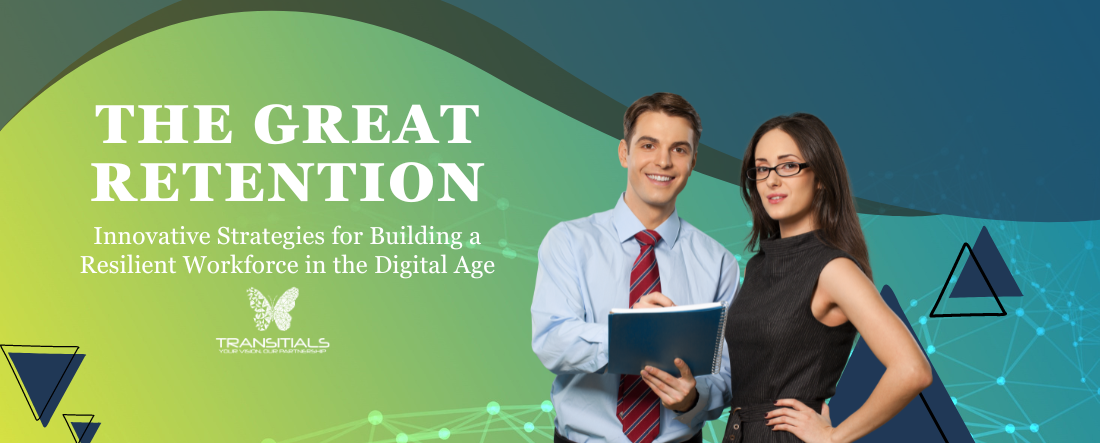The Great Retention: Innovative Strategies for Building a Resilient
Workforce in the Digital Age
Following the ‘Great Resignation,’ churn among workers has reached heights no way ahead seen in history — a global management migraine. For creative organizations, once the dust begins to settle (which it will, in time) this means swirling beyond filling jobs seats and towards nurturing a stayer-thriver pool. Welcome to the period of the “Great Retention” proving that manpower adaptability is a cornerstone of organizational success.
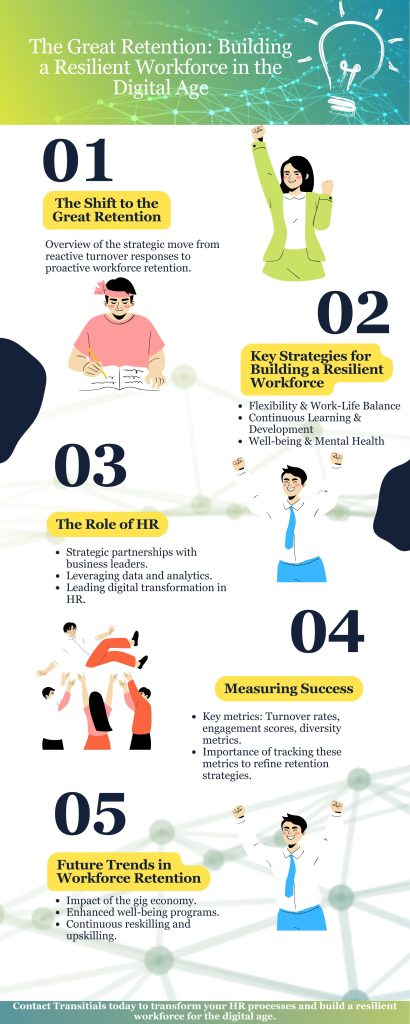
Understanding the Factors Driving Employee Turnover
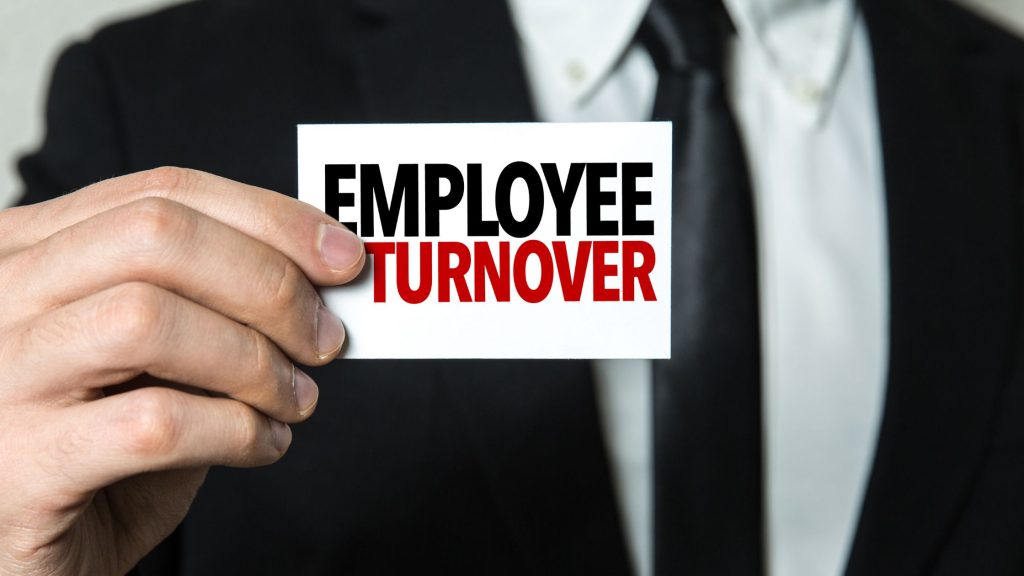
But retention strategies come in later, before that one needs to understand what is driving the employees out of the door. Today, the modern workforce is undergoing a sea of change in their priorities and expectations:
- Work-Life Balance (most important): Fueled by the pandemic, a new era like work-life balance took over and people have shifted towards adapting flexibility or personal time versus the traditional way of office-bound roles.
- Value Alignment and Purpose: Employees, even more so millennials and Gen Zs, are said to be pleased with jobs that align well with their personal values and give them a sense of purpose other than receiving pay.
- Career Growth Opportunities: Stagnation is a major push factor. Individuals are likely to leave if there is no clear pathway for advancement or skill development in sight.
- Workplace Culture: A toxic work environment, lack of inclusivity, or bad management practices are reasons why even the most talented employees might look elsewhere for better options.
- Compensation and Benefits: By no means the sole reason, uncompetitive pay and benefits packages remain one of the most frequent causes of job hopping.
- Burnout and Stress: The increasing workload and recently the challenge of the pandemic accelerated the proliferation of burnout. Understand these, and one would create effective retention strategies.
Understanding these factors is the first step in crafting effective retention strategies. As Shailza Khosla, founder of Transitials, notes, "In order to retain talent, organizations have to start off with understanding what makes people stick. It's about aligning the organizational goals with the aspirations of an individual."
Innovative Retention Strategies Beyond Compensation
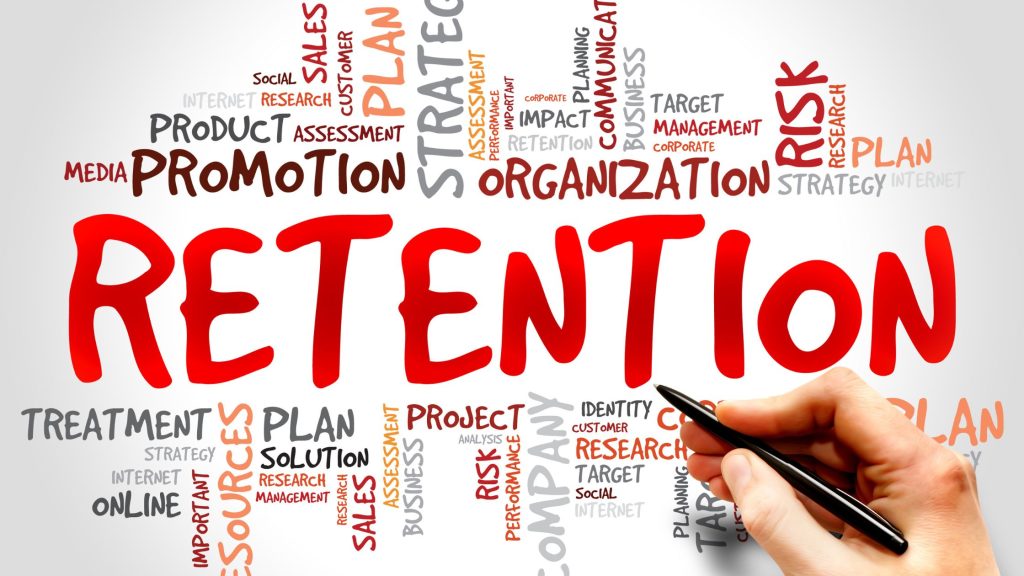
Competitive compensation is a huge thing, but smart organizations are looking at holistic drivers of retention that have a timeless impact:
- Flexible work arrangements including a hybrid model, flexible hours, or remote work to cater to all employee’s requirements and preferences.
- Career-oriented development gives the tools and avenues for team members to design a specific career path aimed at giving resourceful milestones and assuming power in attaining what their career aspirations are within the company.
- Wellness programs focused on the physical, internal, and fiscal well-being of the employees.
- An effective recognition program is needed that will recognize significant triumphs, minor successes even little wins in the office.
- Long-term staff within a company are frequently awarded sabbaticals or extended leaves, allowing them to take a break and catch up with life.
- The internal Gig economy offers workers the chance to work across functional systems or fill temporary assignments that expand their skills and network inside the organization.
As veritably correctly said by Shweta Arora, the co-founder of Transitials, “Retention strategies should be as different as your pool itself. It's about creating an ecosystem where all individuals can be on their unique path to growth and fulfillment.”
Building a Culture of Continuous Learning and Growth

A culture of continued learning is not just a nice to have but a must in this retention era. This is how an organization can encourage continuous skill development in an employee’s DNA:
- Personalized Learning Plans: Utilize AI and machine literacy to curate personalized learning plans that align with the career ambitions of each person and the requirements of the business.
- Microlearning Opportunities: They relate to short pieces of information that workers can learn on the run, making skill development broad and accessible.
- Peer-to-Peer Learning: One approach to this may well be through mentorship programs, lunch- and- learn sessions, or internal wikis that promote additional knowledge sharing among peers.
- Learning Stipends: Provide annual learning stipends for courses, conferences, or other educational materials of choice to every employee.
- Skill-Based Career Development: Link career advancement with skill development that provides a natural motivation for lifelong learning.
- Discovery Time: Another example of how to give employees time to commit to their passion projects or ideas for innovation. This is necessary to support their creative side and let them acquire new talents.
Transitials supports an approach to learning and development that is technology-integrated and human-centric. Indeed, as our case studies show, comprehensive learning ecosystems bring about higher retention rates but better employee performance and satisfaction.
The Role of Purpose and Values in Employee Retention
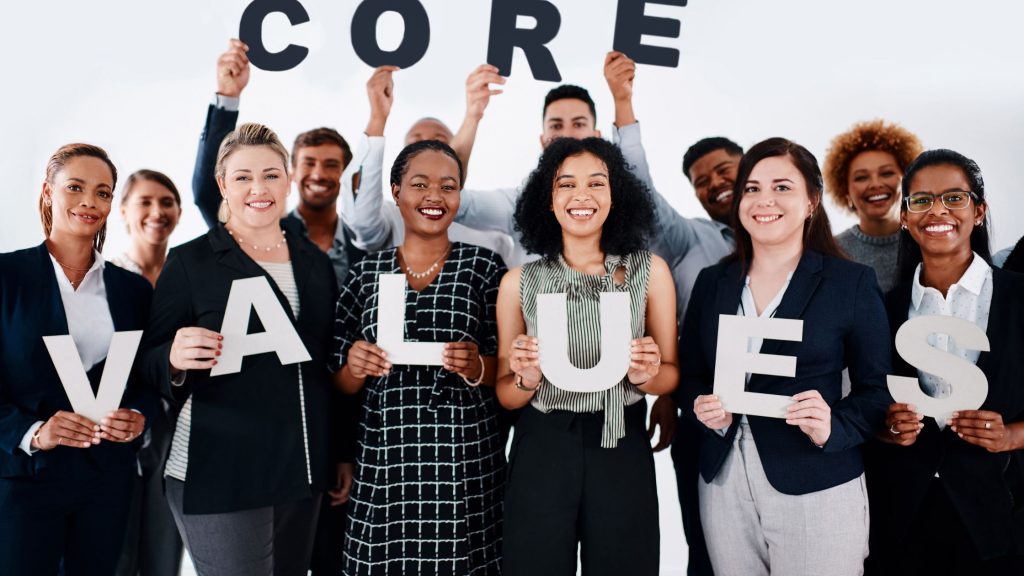
At a time when employees want their jobs to have significance, the organizational purpose and values are to be kept in tandem with individual aspirations. In addition, it is the opportunity for companies to more tightly align this way by:
- Strong Mission: Developing and expressing a strong mission employees are drawn to, forming this into something great so that people want more from their job than just a paycheck.
- Values in Action: How organizational values are operationalized through practices and decision-making.
- Social Impact Initiatives: Involving employees in CSR activities helps them get involved in things that matter to them.
- Open and Honest Leadership: This relates to creating a relationship between Senior Executives and employees, in which Senior Executives give constant feedback on the company’s direction, state, health (financial and otherwise), issues it is facing, etc. which motivates people across the organization by inciting empathy/fellow feeling around successes as well as woes faced by the company.
- Employee Resource Groups: Help to form business-aligned and employee-interest-driven ERGs that create community and a sense of belonging.
- Purpose-Driven Performance Metrics: Integrate purpose-alignment into performance evaluations, where the evaluation ETAs underline how employee goals drive results for the organization.
Transitials have shown how core values such as Customer First, Integrity, Continuous Improvement, Build Partnerships and Teamwork can be infused right into the DNA of the organization. In this way, employees feel connected to a higher cause and that is something which will increase retention greatly.
Transitials' Methodology for Creating Sticky Employee Experiences
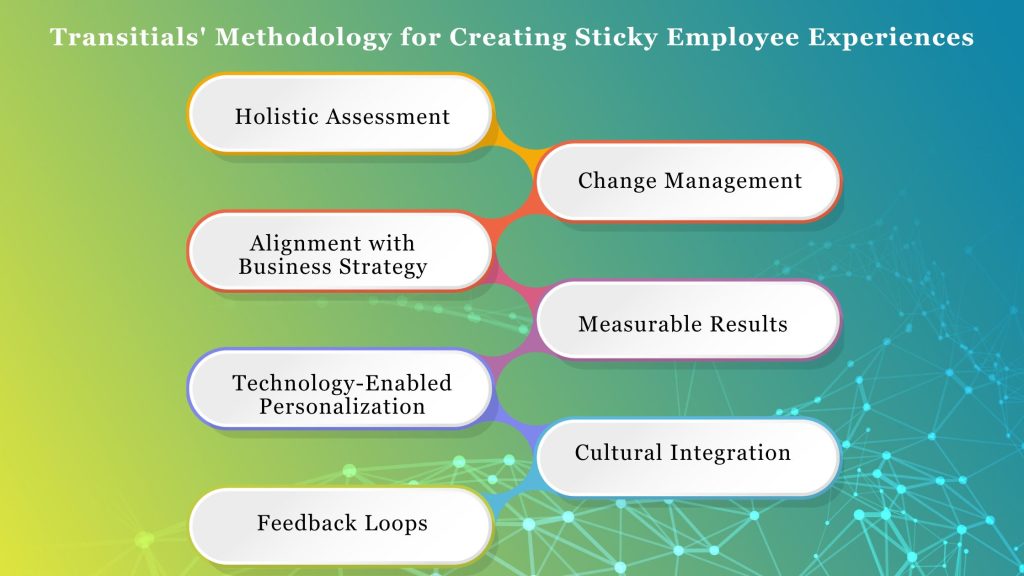
Drawing from the experience of Transitials in HR transformation, we generalize a way of creating "sticky" employee experiences-the ones that will make employees keen to stay and grow with an organization:
- Holistic Assessment: Undertake an overarching assessment of the present employee experience, based on which pain points and areas of excellence will be identified throughout the employee lifecycle.
- Alignment with Business Strategy: Retention strategy needs to fall under key business imperatives, which is one of the key messages in the HR transformation journey.
- Technology-Enabled Personalization: Using the HR tech stack to create personalized journeys throughout an employee’s career, starting even prior to onboarding.
- Loop of Feedback: Establish real-time feedback mechanisms tuned into the voice of the employees at periodic intervals, thus taking the pulse checks which shall avoid issues well in advance.
- Change Management: Employ effective change management upon the implementation of new retention initiatives to ensure that the initiatives are bought and adopted at all levels.
- Quantifiable Outcomes: Clearly define KPIs for each of the retention initiatives; adopt the best practices and make evidence-based adaptations.
- Cultural Integration: The idea that retention strategies intertwined with the culture of the organization are best done organically rather through a specific program or programs in isolation.
This is also in line with the people-process-technology alignment focus of Transitials. It is thus this structured yet agile approach that shall help the organizations in creating an employee experience that is not only attractive but truly "sticky."
Conclusion: The Path Forward
Building a resilient workforce takes a lot in this era of the Great Retention, anything from tackling root causes of turnover to introducing innovative retention strategies, creating a learning culture, aligning purpose and values, and crafting sticky employee experiences. Thus, it equips organizations with a variety of tools.
The key now is to understand that one-size-fits-all retention doesn't work. As suggested by the approach taken by Transitials, it requires a deep understanding of your unique organizational setting, continual advancement, and a will to change with your manpower.
By embracing these strategies and principles, businesses will come up not just scarred survivors of the storms brought about by talent volatility, but stronger, with an engaged and faithful staff primed for long-term success. As the founders of Transitials have said," Success is a journey." Make it an expedition your workers want to stay on, and you will find yourself at the leading edge of the Great Retention.
The key now is to understand that one-size-fits-all retention doesn't work. As suggested by the approach taken by Transitials, it requires a deep understanding of your unique organizational setting, continual advancement, and a will to change with your manpower.
By embracing these strategies and principles, businesses will come up not just scarred survivors of the storms brought about by talent volatility, but stronger, with an engaged and faithful staff primed for long-term success. As the founders of Transitials have said," Success is a journey." Make it an expedition your workers want to stay on, and you will find yourself at the leading edge of the Great Retention.

